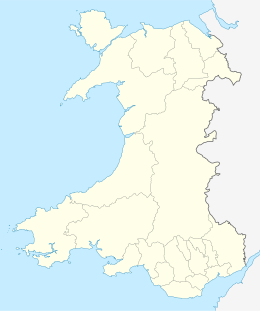Aberconwy Abbey
| Cistercian Abbey Aberconwy / Maenan | |
|---|---|
 The former monastery church in Aberconwy |
|
| location |
|
| Coordinates: | 53 ° 16 '51 " N , 3 ° 50' 0" W |
| Serial number according to Janauschek |
479 |
| Patronage | St. Mary of All Saints |
| founding year | 1186 |
| Year of dissolution / annulment |
1537 |
| Mother monastery | Strata Florida Abbey |
| Primary Abbey | Clairvaux Monastery |
Transfers from Aberconwy Abbey |
Aberconwy Abbey (Aberconwayum) is a former abbey of the Cistercians in the Welsh town of Conwy . The monastery was at the mouth of the River Conwy .
history
The monastery was founded as the first Cistercian foundation in North West Wales in 1186 in Rhedynog-felen in the parish of Llanwnda near Caernarfon by the princes of Gwynedd as a daughter monastery of Strata Florida Abbey and thus belonged to the filiation of Clairvaux primary abbey . Because of the poor living conditions at the founding site, it was moved to the center of Conwy in 1192 at the latest, where it developed into the most important Cistercian abbey in North Wales. Located on the banks of the river in Conwy, the Gwynedd monastery served as a home monastery and burial place. Among other things, they were buried here;
- Llywelyn ap Iorwerth (Llywelyn the Great), † 1240;
- his successor and son Dafydd ap Llywelyn , † 1246;
- and his firstborn son Gruffydd ap Llywelyn Fawr , † 1244 during an attempt to escape from the Tower of London; the Abbeys of Strata Floria and Aberconwy moved it here in 1248.
As the house monastery of the Welsh ruling family, it was richly endowed in 1199 by Llywelyn ap Iorwerth and achieved importance for the princes of Gwynedd because of its support. On November 9, 1277, the Treaty of Aberconwy was concluded in the monastery , which ended the first campaign of the English King Edward I against Wales . After his second campaign against Wales, Edward I moved the monks in 1283 to make the monastery grounds available for the construction of Conwy Castle and the city of Conwy. As compensation, the monks received over 386 pounds , whereupon they decided to build a new building site for the monastery, around 12 km upstream and south of Conwy. The previous monastery church became the parish church of the new town of Conwy. Edward I regarded the new monastery at Maenan (also known as Aberconwy II ) as a royal foundation and was present at the consecration. The monastery was dissolved in March 1537 and given to the Wynne family.
Buildings and plant
The church in Conwy, which has been rebuilt several times, still has the original structure in the west and east. The tower, nave and sacristy date from around 1300 and the south transept from the early 14th century, the side aisles from the middle of the 14th century. The wooden furnishings are partly from the 15th century. Nothing has survived from the cloister buildings in Conwy to the north of the church.
In Maenan, after the dissolution of the monastery, all buildings were demolished except for the foundations and transported to Caernarfon as building material . In the area of the west wing of the enclosure, possibly on the site of the abbey, the manor of the Wynne family was built. The Maenan Abbey Hotel, which still exists today, was built in place of the manor house from 1848 to 1852. To the east of today's hotel, the remains of the eastern cloister and the abbey church were uncovered in 1963 by LAS Butler. The church was a cross-shaped complex with a choir that was just closed, and the enclosure was - as in Conwy - in the north of the church.
literature
- LAS Butler, DH Evans: The Cistercian abbey of Maenan, Gwynedd: excavations in 1968 . In: Archaeologia Cambrensis , 129 (1980), pp. 37-63
- LASButler: The boundaries of the abbey of Aberconwy at Maenan, Gwynedd . In: Archaeologia Cambrensis , 130 (1981), pp. 19-35
- Anthony New: A guide to the Abbeys of England and Wales. Constable & Company, London 1985, ISBN 0-09-463520-X , pp. 36-37 (Aberconwy), pp. 247-248 (Maenan).
- David Robinson (Ed.): The Cistercian Abbeys of Britain. Far from the Concourse of Men. Batsford, London 1997, ISBN 0-7134-8392-X , pp. 64f.
- David, H. Williams The Welsh Cistercians. Gracewing, Leonminster 2001, ISBN 0-85244-354-4 .
Web links
- Aberconway . www.cistercensi.info. Retrieved October 7, 2010.
- Maenan . www.cistercensi.info. Retrieved October 7, 2010.
- Website of Cistercians Sheffield with a photo (english)
- But Conway I . RCAHMW - National Monuments Record of Wales. Retrieved April 14, 2014.
- Maenan / Aberconway II . RCAHMW - National Monuments Record of Wales. Retrieved April 14, 2014.
Individual evidence
- ^ Robinson, David M .: The Cistercians in Wales: Architecture and Archeology 1130-1540 . Society of Antiquaries of London, London 2006. p. 224
- ^ David Walker: Medieval Wales . Cambridge University Press, Cambridge 1990. ISBN 978-0-521-31153-3 , p. 157


